|

|
COMMENTARY
|
NOTE: This commentary is based on several different
sources. Sylvia Stoddard is perhaps the
greatest one. The many phone and e-mail
conversations I had with her inspired me to write this. Her website, EVITA ONSTAGE, which sadly no
longer exists, had a wonderful commentary section. Sylvia told about her vast experiences with
the show (after all – she was there!).
I will not lie – I’ve never seen Patti LuPone
or Elaine Paige or Tim Rice or Paloma San Basilio in person before – but she did. Therefore, a lot of this comes from her
experiences, not mine. I also took a
great deal of information from Michael Walsh’s excellent book, Andrew Lloyd Webber: His Life and Works. I recommend this book to anyone who is
interested in finding out more information about his shows. This commentary is for private use only
– I wrote it so that visitors to my website could understand the
masterpiece this show is – please forgive the length – but
it’s a very long story….
In the beginning…
|

Andrew Lloyd Webber & Tim Rice
|
Like its predecessor Jesus
Christ Superstar, EVITA started out in a recording studio. Tim Rice, the show’s soon-to-be
lyricist, became interested in creating a show about Eva Perón
after hearing part of a British radio program on her life. He talked to Andrew Lloyd Webber about his
idea, but Andrew (at first) wasn’t impressed with the idea. Andrew was dead set on creating a musical
based on the P.G. Wodehouse character Jeeves. Tim
wasn’t impressed with Andrew’s idea and flew to Buenos Aires to research the myth that is Eva Perón
(though any hard research would have been too dangerous considering the
political situation in Argentina at the time). Upon
returning to England, Tim presented his findings to Andrew (who had suffered a
huge flop with his show Jeeves). Andrew relented to Tim’s idea and the
two set out to create a show in the completely sung-through style of Jesus
Christ Superstar.
|
By 1976, EVITA
had been completed. The duo decided to
go the same production route with EVITA as they had done with
Superstar: first release a single,
then a complete recording, and finally, put the whole shebang on stage. The single was complete, though Tim and
Andrew didn’t like the sound of the first line:
It's
only your lover returning
The
truth is I never left you
All
through my wild days
My
mad existence
I kept my promise
Don't
keep your distance…
The song was to come at the point in the show
when Eva returns from her Rainbow Tour.
In that context, the first line made perfect sense, though it
wasn’t catchy enough. Tim tried a
couple of other lyrics until he pulled a line he had written in the funeral
scene, “Don’t cry for me, Argentina”
– the title was catchy and exotic enough to get some radio
attention. MCA Records released the
single (with “Rainbow High” on the B side). The song quickly climbed the charts to #1.
The Concept Album was released later that
year. The record starred Julie Covington
as Eva, C.T. Wilkinson as Che (who would later become
the superstar Colm of Les Misérables fame) and Paul Jones as Perón. The recording was quite successful (even
considering the embarrassing insecticide subplot!).
“And the
insects fall like flies – Kapow! Die!”
The recording mixed classic rock, pop, jazz,
classical and Latin themes to create a unique sound.
Julie Covington’s rendition of
Eva’s last words, “Lament”, is perhaps the most beautiful
ever recorded. Unfortunately, one of the best verses in the song would later be
cut from the stage production:
|
The choice was mine and no one else's
I could have the millions at my feet
Give my life to people I might never meet
Or else to children of my own
Remember I was very young then
Thought I needed the numbers on my side
Thought the more that loved me the more
loved I'd be
But such things cannot be
multiplied…
|

Julie Covington
|
This was followed up by the line that would be Eva’s
theatrical final words:
Oh my daughter!
Oh my son!
Understand
what I have done!
Out of context, these lines serve as an awkward
ending to Eva’s life. Eva never had children, and therefore sacrificed maternity for
fleeting style, glamour, fame, and popularity.
Although EVITA was a
popular recording, it was neither Tim’s nor Andrew’s desire to have the success of EVITA
stop in record stores.
Next stop will be London…
Production costs were no worry to Andrew and
Tim as the Concept Album had sold over two million copies worldwide.
Enter Harold “Hal” Prince.
Prince, a director of varied musicals (Candide,
A Little Night Music, Company, Follies, and Cabaret
just to name a few), had wanted to acquire the rights
to Jesus Christ Superstar. He didn’t get his way, though this
inspired him to try even harder for the rights to EVITA. He informed the duo of his desire. The duo became a trio.
|
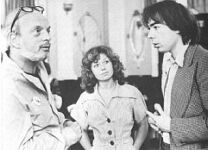
Prince,
Paige and Lloyd Webber
|
Tim, Andrew and Hal set out to make
a visual EVITA that, up to that point, had only been an aural one. Tim
desperately wanted Julie Covington to play Eva on stage, though she would not hear of it. Therefore, a “call to arms” to
find an Eva Perón started.
One day, a tiny bundle of
dynamite by the name of Elaine Paige came to audition. Elaine had played in the chorus in Superstar and had
been in a few other shows, though she was on the brink of giving up musicals
outright. Nevertheless, her agent
convinced her to try out.
|
She sang “Don’t Cry for Me, Argentina”
and was asked by Andrew to sing “Rainbow High.”
Elaine looked at him square in the eye and
said:
“Oh
fuck, I haven’t got the music.”
As they say, a star was born.
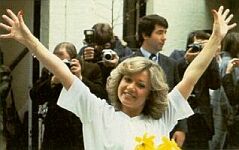
|
Harold Prince wanted
the character of Che to be identified with
revolutionary leader Ernesto “Che”
Guevara. Guevara was an Argentine, and
was in his late teens during the Peronist
regime. Therefore, it’s not
absurd to think that El Che’s later political
ideas in Cuba were an attack on the corrupt government of his youth. David Essex, who had starred in Godspell, was cast as Guevara. He also received top billing because his
name was better known at the time than that of the relative newbie Paige.
Prince streamlined the show and
took out the awful insecticide subplot (which unfortunately deleted a
wonderful rock basher, “The Lady’s Got Potential.”) In its place, Prince added an interesting
political game of musical chairs, “The Art of the Possible.”
|

David Essex
|
|
Timothy
O’Brien and Tazeena Firth were called in by
Prince to help design the show. And design they did! A giant movie screen would dominate the
stage would show documentary film reels of the real Evita
doing what she did best: smiling and
waving.
It would serve not only as a
constant historical reference, but also as a backdrop of the various locales
in the show. In Eva’s early
days, the screen shows a picture of a dusty Argentine town – only to
change to flashing images of the busy Avenida 9 de
Julio and fashionable Calle Florida when
Eva makes it to the big city. In Act
Two, the screen becomes the façade of the Casa Rosada
and takes us along with Eva as she tours Europe in the
Rainbow Tour scene.
|
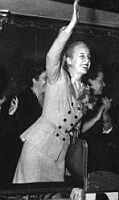
|
The floor of the stage was to have a set of lights embedded
in a pattern that would allow various stage images. The lights could be lit on just stage left
and stage right (to set off the ‘boxing ring’ in the Waltz scene);
the semicircle could be lit up (to make eerie shadows in “The Art of the
Possible”) or all the lights could flash in random order (when Eva
trickles down her “little touches of star quality” at the end of
the “Buenos Aires” number).
The lights looked something like
this:

Eva’s costumes were based on actual
photos. The now famous “balcony
dress” was based on a Dior gown of Eva’s. Though O’Brien and Firth couldn’t
have known it, the dress was actually gold, not white (as it became on stage). The designers assumed the color was white
from the black and white photos taken of that particular gown:
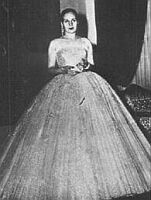
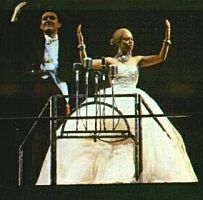
The whole set had a neo-Brechtian
look which made it very simple to travel (and travel it would!).
|

|
A creative logo was created which
took a modernistic silhouette of Eva’s smiling face (complete with
Eva’s ubiquitous chignon) and placed it on top of the rays of the sun
from the Argentine flag. Today, it’s as easily recognizable as the Phantom
mask, the Cats eyes or the Cosette figure
from Les Misérables.
|
EVITA premiered
in London on 21 June 1978 at the Prince Edward Theatre to much
fanfare. Elaine Paige, the little chorus
girl with a voice like TNT, was now
the toast of the West End. Nevertheless, reviews were mixed. The critics who had shouted
“BLASPHEMY!” at Jesus Christ Superstar’s première were now shouting “GLORIFIED
FASCISM!” at EVITA’s
opening. Many took the show to be Tim
Rice’s personal views on politics (though Tim was more interested in Evita’s good looks than her bad politics).
A few months into the run, Elaine started having
problems with her voice. The score to EVITA is quite
rangy for the character of Eva. Add to
the fact that Eva is on stage for about 90% of the show and sings for well over
three-quarters of it. Elaine had to
relent 2 of her 8 weekly shows to her understudy, Susannah Fellows. This created the now common-place occurrence
of having an Eva and an alternate Eva.
Despite all odds, EVITA ran for
eight solid years and made stars out of the women who came after Paige: Marti Webb, Stephanie Lawrence, Jacquey Chappell, Siobhan McCarthy (who had starred
originally as Perón’s Mistress), Jacquey Chappell and Kathryn Evans.
California here we come…
In 1979, EVITA crossed the ocean. The success of the Concept Album wasn’t
as well founded in the United
States.
The recording received little radio airtime because it wasn’t
easily categorized (was it rock? pop? jazz? Latin?)
Instead of having a big opening on Broadway,
the producers decided to test the American waters by having a première in the
city that’s about as far away from New York as you
can get in the States: Los
Angeles.
Rumors flew about who would play Eva. Producer Robert Stigwood, supposedly wanted Ann-Margret
- no - Raquel Welch - no - Charo (!) - no - Meryl Streep
- no -
|
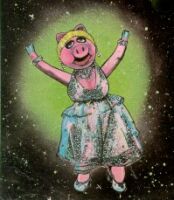
|
|
MISS PIGGY?!?
|
Enter La LuPone.
Patti LuPone was a
27 year-old Juilliard grad who was working on Stephen Spielberg’s 1941 at the time
auditions were announced. At her
audition, Prince was enchanted. She got
the role. Obscure play star Mandy Patinkin was cast as Che
(everyone knew he could act – but the fact that he could sing was not
only surprising but quite exciting) and Bob Gunton
was set to play Colonel Perón.
|
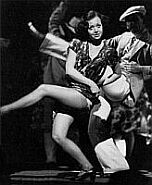
Elaine Paige
|
With the company in place, some changes to the show were inevitable. Though Tim Rice’s
lyrics were very popular, certain anglicized phrases like “Get
stuffed” had to be changed to suit American tastes (as if “Up
yours!” is tasteful). The
score was revised (for example, the rhythm section in “Buenos
Aires” changed from rock guitars strumming away to a catchy Brazilian
samba beat played on piano) and some things were cut. Patti LuPone
rejected Larry Fuller’s kick-up-your-heels choreography in the “Buenos Aires” number. Patti
quipped:
“[He] had me chugging along
like a damn train!”
|
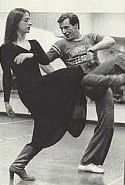
Patti LuPone
& Larry Fuller
|
This was one of many nuances that would later come to iconify the cast. Others
included:
Patti’s infamous slurring of Tim Rice’s already
slippery words (“fillmeupwithyaheatwithyanoisewithyadirt…”),
her punching the hell out of “star-qual-i-ty!”
at the ends of “Buenos Aires” and “Rainbow High”, and her gasp of breath as she asked Argentina
not to cry for her became as well-known as the soon-to-be-diva herself (all of
which would be parodied in Forbidden Broadway recordings!).
Mandy added his unique ability at accents to
a somewhat lagging “Rainbow Tour” number. His trilingual romp through Europe made the
number a lot easier to listen to. Of
course, who could forget the British ambassador’s “On the 9th February 1935…”?
Bob’s trilling of EVERY “r”
in the entire show made the viewer ask, “If everyone in this show is from
the same country, why does HE have the funny accent?”
These idiosyncrasies brought forth the
question: “How does one
‘freeze’ a show when each cast is uniquely different?” Harold
Prince had neither the will nor want to work with each future cast’s
quirks. The answer was simple. Patti’s cast was to be the norm. The show was “frozen”.
Opening night was on 9 May 1979 at the Dorothy Chandler Pavilion.
The fear that Patti would lose her voice like Elaine had was
allayed by the casting of her alternate, Terri Klausner. Terri wound up getting the great reviews that
Patti had wanted. The strain of several
shows a week and recording the cast album (which, despite all odds won a Grammy
Award in 1980) was grinding away at Patti.
Plans were already made for the show to travel to San
Francisco, and then move to Broadway.
The unthinkable occurred at closing night in L.A. By the middle of Act I, Patti had stopped
singing except when she absolutely had to.
By the end of “A New Argentina”,
Patti’s voice was gone. Backstage
was in an uproar. Terri Klausner would have to go on, but her costumes and wigs had
already been packed up for the trip to San
Francisco.
Terri went on in Act II, and gave the performance of her life that
night, while Patti wept in her dressing room.
|
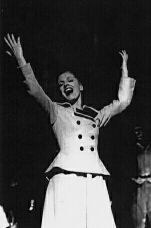
Patti LuPone
|
By the time the show made it to San Francisco, Patti’s voice was still obviously suffering, and
reviews were not the best. Hal Prince
reassured Patti and it was at that moment that she realized the weight of the
show was on her shoulders.
EVITA headed to Broadway and took it by storm. Patti had worked out her vocal troubles,
and took the show by the reins. She was now the diva we all know and
love. As for Terri Klausner…
she never really got a chance to become the star (as was the case in London
– for example, Stephanie Lawrence was Marti Webb’s alternate -
when Marti stepped down, Stephanie took over the lead).
Rumors about a soon-to-be-made movie version began
to fly (oh,
if they only knew).
|
Forbidden
Broadway created a hilarious parody that set the tone of the day:
Don’t cry for me,
Barbra Streisand!
The truth is you bought
[gasp] the film rights!
Though you’re a belter—
And very shrewish—
You’ll ruin the
movie – ‘cause you’re too Jewish…
The incessant rumors would not stop until 17
years later when a material girl from Michigan took EVITA to the
silver screen.
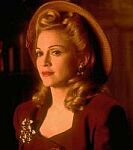
Madonna
Despite mixed reviews (as in London), the
show won seven Tony Awards (including one for Patti – she really had come
a long way). EVITA was
wildly popular. A disco album of the
score was recorded and a TV commercial was recorded that featured Patti with
her punching “star-qual-i-ty” bit.
|
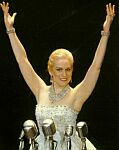
Florence Lacey
|
The show made an unprecedented move in 1980 –
there were to be TWO national touring companies – one starring Loni Ackerman to begin in Los
Angeles and one starring Valerie Perri in Chicago. A few years later, two more touring
companies would begin – and a woman named Florence Lacey
would take over the role. “Flo” became the last Eva on Broadway when the show
finally closed in June 1983 – she would soon hold the title as the
woman who played the role more than any other in the world.
|
EVITA down under…
|
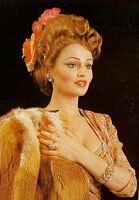
Jennifer Murphy
|
In 1980, while EVITA began
touring in the States, producer Robert Stigwood
wanted to take the show to his hometown of Adelaide,
Australia. Jennifer Murphy was
cast in the title role. The showed
toured Australia, and a few years later, the show was produced in New Zealand starring English actress Michele Breeze (who was to take over
the role in London, though never got the chance to). When Murphy fell ill, Patti LuPone flew to Australia to play the role. Cast recordings were made of both the
Australian and New Zealand casts.
It was time to translate EVITA…
|
No llores por mí, España...
It was only befitting that the first language EVITA was
translated into was Spanish. Though
Spaniards are not generally fond of Broadway-style musicals, Jesucristo Superstar had played
there to wild acclaim. The Madrid
production of the show became the first version to break the Harold Prince
mold. Though the gist of the
show’s setup remained, there were some unique touches that made the Madrid version
very interesting. First, and perhaps
most importantly, the score was re-orchestrated with a true Argentine
flavor. A bandoneón (a small
“squeezebox” accordion used in tango), acoustic guitars and other
Latino instruments were used to orchestrate the show. The cost of hiring an orchestra nightly to
play such lavish instruments would have been stellar, so the Madrid cast
recorded the score on tape to use for the performances.
The costumes also reflected the characters
better. Magaldi
was no longer a stereotypical Latino heartthrob with ruffles and a slick,
greasy hairdo (could
someone tell me whose idea that was?). He was
transformed into an Argentine TANGO SINGER, which is what he was anyway.
|
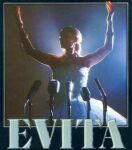
Madrid Logo
|
The logo for the show featured Mia Patterson, Paloma’s
alternate, because Paloma felt Mia’s profile
looked more like the real Eva’s.
The Madrilene
première was in December 1980. Paloma San Basilio played the
role to the tee. Her shrill voice was
electric and captured the spirit of the real Evita.
Patxi Andión toned down
the spitting, furious Che Guevara that Hal created
and made him a softer man – whose voice constantly hinted at violence.
|

Paloma San Basilio
|
The show was quite popular in Spain (and many
people could still remember when the real Evita
“went on tour” there!) and transferred to Barcelona for a
while.
In 1983, Paloma
toured Latin America with the show making stops
in Puerto Rico, Venezuela, Colombia and
several other Latin American nations – though Argentina was not
on the list.
Glitter und glanz!
|

Isabel Weicken
|
About a month after the Spanish
première, Harold Prince directed the first German language production at the
Theatre an der Wien in Austria. The translation was a
little awkward as the translator wasn’t the best English speaker.
Nevertheless, the show (starring Isabel Weicken and
Alexander Goebel) did well in both Austria and Germany.
After the German tour, the
company went back to Vienna. Weicken was
attacked outside of her home and her face was badly injured. After an investigation, it became clear
that Weicken’s alternate, Vera Gutman, had paid men to injure her so that she could go
on in the role! Gutman
was forced out of the show. (So much for star quality, huh?)
|
No llores por mí,
México...
Students of linguistics know that the Spanish spoken in Spain is quite
different from the Spanish spoken in Mexico. Despite the beauty of the Madrid
translation of the show, it was not acceptable for the Mexican production. Marco Villafán had
the daunting task of retranslating the entire show. The translation was much closer to English
(and perhaps easier to understand), though not as poetic as that of Spain.
Like the Spanish production, Mexico
City used a taped orchestration for the
performances. The show reverted to the
Broadway costumes and orchestrations.
|
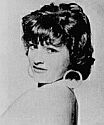
Rocío Banquells
|
Rocío Banquells and Valeria Lynch
co-starred in the main role. They
would both become popular musical theatre actresses (Banquells
would go on to star in Cats and Lynch would play in Kiss of the
Spider Woman).
For all you trivia buffs,
Valeria Lynch was the first Argentine woman to play Evita.
The Mexican cast album featured Banquells, though Lynch put out a single LP titled “Valeria
Lynch: Lo Mejor
de Evita”.
|
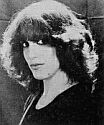
Valeria Lynch
|
Konnichiwa Buenos Aires!
|
In 1982, a unique production began
in Tokyo. The costumes, sets
and orchestrations were all rethought – and the cut song “The
Lady’s Got Potential” was revived and was used along with
“The Art of the Possible.”
The Japanese traditionally do not show beds on stage,
therefore, several scenes had to be altered.
“A New Argentina” featured Eva fully clothed in the dress that
traditionally was used in the “Rainbow High” number. “Lament” featured Eva lying on
the stage in a purple robe whilst bathed in light. When Eva dies, the light is cut off (cool,
huh?)
|
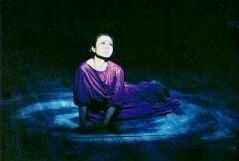
Akiko Kuno
|
A singer named Akiko Kuno (who had
played in Japanese productions of West Side Story and Jesus Christ Superstar) played
Eva. Akiko had a unique portrayal of the
role and in 1997, took Japanese TV viewers on a tour
of Buenos Aires.
Não chores por mim,
Brasil!
The Brazilian production premiered in 1983 in Rio de
Janeiro at the Teatro
João Caetano.
Victor Berbara, the
translator, used the Madrid
translation as a basis, and created a very beautiful version. His “Ponho o Mundo a Teus Pés”
(“I’d Be Surprisingly Good For You”)
is particularly interesting when translated:
|
I
don’t speak of a vulgar love,
An adventure, and
after, goodbye,
That which I want is to
show you
It was destiny that
brings us together
I swear by God, I will
live for you…
I put the world at your
feet…
|

Cláudia
|
A singer by the name of Cláudia
(just Cláudia – think “Cher” or “Madonna”)
played Eva. Her voice is one of the most
unique of all the Evitas. She used her multi-octave voice to
accentuate the score. Putting touches on
songs such as “I’d Be Surprisingly Good
For You” and “High Flying, Adored” brought the house down
every night. On the cast album, instead
of hitting the low E at the end of “Buenos
Aires” and “Rainbow High”, she ratchets
up an octave or two!
And everywhere else...
EVITA
has
now been performed on every continent (except Antarctica of course
– though Andrew Lloyd Webber is probably mounting the first production
there as you read this). The show has
been heard in English, both Spain Spanish and Latin American Spanish, German,
Portuguese, Dutch, Danish, Swedish, Norwegian, Icelandic, Finnish, Bulgarian, Polish,
Estonian, Romanian, Greek, Japanese, Korean, Czech, Hungarian, Turkish, and
Hebrew. There are more than two dozen
cast recordings of the show, and many of them are complete.
Sadly, many of the performers and people who
have worked on the show are now no longer with us – producer David Land,
Stephanie Lawrence in England, Gé Korsten
of South Africa, Carlos Augusto Strazzer
of Brazil, Tony Alvarez of Australia, and most of the Greek cast…
Have I said too much?
There’s nothing
more I can think of to say to you…
EVITA has come a long way – and hopefully has a long way
to go. To Tim Rice, Andrew Lloyd Webber,
David Land, Robert Stigwood, Harold Prince, and all
those who have made the show possible over the years, I thank you from the
bottom of my heart for the many years of enjoyment you have brought me!
_____________________________________________________________________________________________________________________________
COPYRIGHT NOTICE
























